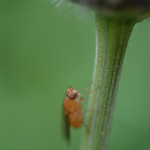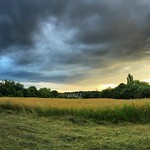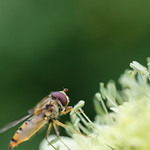DSLR cameras get bigger, the more high end they are. In some respects this is great: larger hands have a better grip on a big camera, for example, but at the same time that size often comes with an increase in weight, too. Add to that the sie and weight of your lenses and your travel bag becomes heavy just from all of that stuff already. Some of the mirror-less cameras have become very interesting. Some offer great picture quality and low light results that are inching every closer to the results of a big DSLR, especially if you are not shooting full frame (FF). I’ve been especially interested in the Fujifilm cameras that are taking a different approach and also favor a very retro design that I just adore. For a long time I was debating if and which Fuji to get. Last summer I decided to get the X20 as an addition to my DSLR and really enjoyed the results. This winter I decided to take the complete plunge:
I bought a Fuji X-E2, which only has an electronic viewfinder (EVF). Something I was very hesitant about but after working with it for a bit, I have to say: I really enjoy using it even though it feels a bit like cheating at times… With the Fuji you have an eye sensor which is used to switch between using the back display for framing your shots and using the EVF to frame your shots. This feels much more natural when you come from a big camera since you are used to an optical view finder. The EVF shows you the results as the camera sees them and interprets them. The X-E2 EVF is pretty fast and accurate and absolutely adequate for my needs (the new X-T1 has an even better one). Now about that cheating: The first night I went out for a night shoot and this is an instance where an optical viewfinder is really not helpful at all. Sure you see everything through the viewfinder but it gives you no info on how you should do the exposure. The EVF on the other hand changes the view based on your settings…Of course you still have to deal with shutter speed and such but I was shooting with the 35mm f1.4 lens from Fuji and this gave me really great feedback on when i still had enough light for a shutter mode or needed to switch to Bulb. Bulb here is great, too – while you hold the shutter button, a timer will appear on the display letting you know exactly how long you are exposing your shots. Pretty nifty.
The Fuji is also all about manual controls – of course you can do everything on Automatic but you can also do everything manually very easily. Much easier than on my Canon 7D at least. You have a dial for setting the exposure compensation, as well as a dial to set the shutter speed and each lens has a manual aperture ring on it, giving you the full possibilities of doing everything manually without having to go hunt into menus or using two or three buttons at the same time to change something.
In addition you can focus manually and this is the area where I really like the Fuji: You have three different manual focus modes. Do it yourself without digital help, like you would on a DSLR, or you can use the Phase Detection Focus Mode where you will see flittering lines surrounding the part of the image that is in focus and as a last option they have included a view that is reminiscent of Rangefinder Cameras: in the middle of the frame you get three grey blocky lines which only align when the object you are focussing on is in focus. I think this might come in especially handy in Macro shots where the Phase Detection might not be precise enough.
Of course you switch focus modes with a manual dial, too. These manual focus modes also work with older manual lenses, so i have bought adapters to use my old Canon FD and M39 lenses with the Fuji, giving me more options from the get go.
One area where I was concerned before picking up the camera was the Macro capabilities of the Fuji. Smaller sensors usually produce not as shallow a depth of field as larger sensors and the Fuji currently only offers one Macro lens (the 60mm f2.4 Macro). So before buying the Fuji and lenses I decided to test the Macro in a store. The Auto-Focus is very slow on the lens but the results are okay for me and I am saving up on the Zeiss Touit macro that is coming soon which hopefully should give me even better results.
Another cool aspect about the Fuji cameras: they do a ton of firmware upgrades, both for the camera and the lenses. This also brings some of the flagship features of newer models onto older models meaning that your camera will be up to date for much longer than it might be traditionally. For example the X-T1 has much higher continuous shooting results than the X-E2 but since both run the same processor and such, Fuji has already announced that they will bring this feature to the X-E2, too.
So far I have only been able to play around with some lenses for short bursts of time but I have been really enjoying both the camera and the results (especially the sharpness) and cannot wait to really take it out for a longer photo shoot.


















